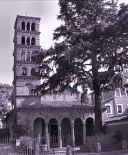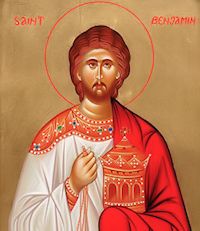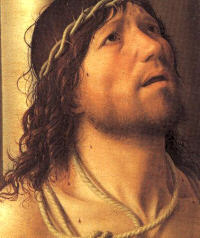Lent: March 31st
Saturday of the Fifth Week of Lent
Other Commemorations: St. Benjamin, Deacon and Martyr (RM)
» Enjoy our Liturgical Seasons series of e-books!
But he knew their thoughts and said to them, "Every kingdom divided against itself will be laid waste and house will fall against house. And if Satan is divided against himself, how will his kingdom stand? For you say that it is by Beelzebul that I drive out demons. If I, then, drive out demons by Beelzebul, by whom do your own people drive them out? Therefore they will be your judges. But if it is by the finger of God that (I) drive out demons, then the kingdom of God has come upon you. When a strong man fully armed guards his palace, his possessions are safe. But when one stronger than he attacks and overcomes him, he takes away the armor on which he relied and distributes the spoils. Whoever is not with me is against me, and whoever does not gather with me scatters. (Lk 11:17-23).
Meditation on the Gospel - Mark 8:34-9:1
When Jesus said, "If any man would come after me...", he was well aware that in fulfilling his mission he would be brought to death on a cross; this is why he speaks clearly about his Passion (vv:31-32). The Christian life, lived as it should be lived, with all its demands, is also a cross which one has to carry, following Christ.
Jesus' words, which must have seemed extreme to His listeners, indicate the standard He requires His followers to live up to. He does not ask for short-lived enthusiasm or occasional dedication; He asks everyone to renounce himself, to take up his cross and follow him. For the goal He sets for men is eternal life. This whole Gospel passage has to do with man's eternal destiny. The present life should be evaluated in the light of this eternal life: life on earth is not definitive, but transitory and relative; it is a means to be used to achieve definitive life in heaven: "All that, which worries you for the moment, is of relative importance. What is of absolute importance is that you be happy, that you be saved" (J. Escriva, The Way, 297).
"There is a kind of fear around, a fear of the Cross, of our Lord's Cross. What has happened is that people have begun to regard as crosses all the unpleasant things that crop up in life, and they do not know how to take them as God's children should, with supernatural outlook. So much so, that they are even removing the roadside crosses set up by our forefathers...!
"In the Passion, the Cross ceased to be a symbol of punishment and became instead a sign of victory. The Cross is the emblem of the Redeemer: in quo est salus, vita et resurrectio nostra: there lies our salvation, our life and our resurrection" (J. Escriva, The Way of the Cross, II, 5).
Jesus promises eternal life to those who are willing to lose earthly life for his sake. He has given us example: he is the Good Shepherd who lays down his life for his sheep (Jn 10:15); and he fulfilled in his own case what he said to the Apostles on the night before he died: "Greater love has no man than this that a man lay down his life for his friends" (Jn 15:13).
Each person's eternal destiny will be decided by Jesus Christ. He is the Judge who will come to judge the living and the dead (Mt 16:27). The sentence will depend on how faithful each has been in keeping the Lord's commandments — to love God and to love one's neighbor, for God's sake. On that day Christ will not recognize as His disciple anyone who is ashamed to imitate Jesus' humility and example and follow the precepts of the Gospel for fear of displeasing the world or worldly people: he has failed to confess by his life the faith which he claims to hold. A Christian, then, should never be ashamed of the Gospel (Rom 1:16); he should never let himself be drawn away by the worldliness around him; rather he should exercise a decisive influence on his environment, counting on the help of God's grace. The first Christians changed the ancient pagan world. God's arm has not grown shorter since their time (cf. Is 59:1). Cf. Mt 10:32-33 and note on same.
Excerpted from The Navarre Bible - St. Mark
Things to Do:
- If you wish to gain the courage to embrace the small crosses in your life with joy, pray the Stations of the Cross. This is an excellent practice that should not only be confined to Lent but ought to be prayed on Fridays throughout the year. An excellent version with beautiful meditations composed by Pope John Paul II is his Stations of the Cross at the Colosseum. Some recommended versions are: Eucharistic Stations of the Cross, and the more traditional Stations of the Cross written by Saint Alphonsus Liguori can be found in most Catholic bookstores. Here are some guidelines for praying the Stations of the Cross in your home.

Today's Station takes place in the Church of St. John before the Latin Gate. This ancient basilica is built near the spot where the beloved disciple was, by Domitian's order, plunged into the cauldron of boiling oil.
St. Benjamin
 The Christians in Persia had enjoyed twelve years of peace during the reign of Isdegerd, son of Sapor III, when in 420 it was disturbed by the indiscreet zeal of Abdas, a Christian Bishop who burned the Temple of Fire, the great sanctuary of the Persians. King Isdegerd threatened to destroy all the churches of the Christians unless the Bishop would rebuild it.
The Christians in Persia had enjoyed twelve years of peace during the reign of Isdegerd, son of Sapor III, when in 420 it was disturbed by the indiscreet zeal of Abdas, a Christian Bishop who burned the Temple of Fire, the great sanctuary of the Persians. King Isdegerd threatened to destroy all the churches of the Christians unless the Bishop would rebuild it.
As Abdas refused to comply, the threat was executed: the churches were demolished, Abdas himself was put to death, and a general persecution began which lasted forty years. Isdegerd died in 421, but his son and successor, Varanes, carried on the persecution with great fury. The Christians were submitted to the most cruel tortures.
Among those who suffered was St. Benjamin, a Deacon, who had been imprisoned a year for his Faith. At the end of this period, an ambassador of the Emperor of Constantinople obtained his release on condition that he would never speak to any of the courtiers about religion.
St. Benjamin, however, declared it was his duty to preach Christ and that he could not be silent. Although he had been liberated on the agreement made with the ambassador and the Persian authorities, he would not acquiesce in it, and neglected no opportunity of preaching. He was again apprehended and brought before the king. The tyrant ordered that reeds should be thrust in between his nails and his flesh and into all the tenderest parts of his body and then withdrawn. After this torture had been repeated several times, a knotted stake was inserted into his bowels to rend and tear him. The martyr expired in the most terrible agony about the year 424.
—Excerpted from Saints and Angels
Highlights and Things to Do:
- Read more about St. Benjamin:
- If you are named after St. Benjamin you can find a medal of him at the Catholic Company.
- St. Benjamin is also honored in the Eastern Orthodox Church and the Byzantine Rite Eastern Catholic Churches on October 13.

Friday of the Fifth Week of Lent
Station with Santo Stefano Rotondo al Celio (St Stephen's Rotunda at the Coelian Hill):
The Station, at Rome, is in the church of St. Stephen on Monte Celio (the Coelian Hill). The church is dedicated first to St. Stephen, the First Martyr, but is also dedicated unofficially to St. Stephen of Hungary. This is the Hungarian national church. This church is southeast of the Colosseum, off the usual beaten path. The actual site of the church was occupied by a set of barracks housing Roman soldiers. The earliest church was consecrated by Pope Simplicius between 468 and 483. Its architecture is unique in the Late Roman world and the oldest example of a circular church, often thought that it was modelled on the Anastasis of the Holy Sepulchre in Jerusalem. Although the inside is circular, the exterior is on a cruciform plan. The church has undergone various periods of ruination, disrepair, and restoration. The relics of the first martyr were never in the church.
Besides being one of the original churches in the round, another key feature is found on the walls of the church, decorated with numerous frescoes, portraying 34 scenes of martyrdom, commissioned by Gregory XIII in the 16th century. Each painting has a titulus or inscription explaining the scene and giving the name of the emperor who ordered the execution, as well as a quotation from the Bible.
For more information on Santo Stefano Rotondo al Celio, see:
For further information on the Station Churches, see The Stational Church.








